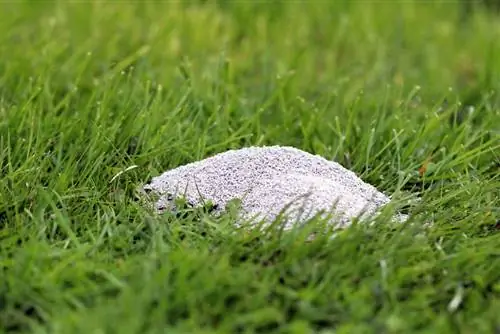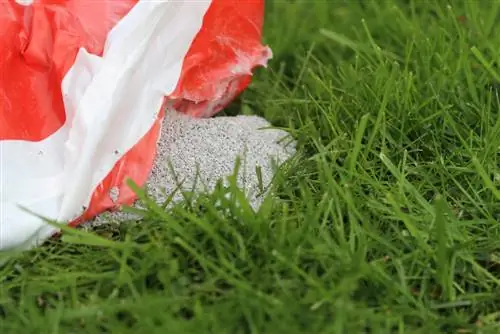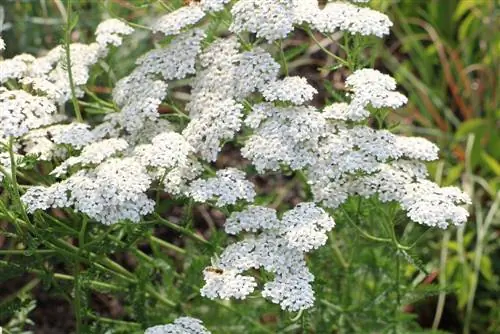- Author admin [email protected].
- Public 2023-12-17 03:39.
- Last modified 2025-01-24 12:45.
Regular pruning of the garden marshmallow not only stimulates flowering, but also keeps the hibiscus dense, strong and in shape. Although it does not require cutting, it rewards plant lovers and hobby gardeners with significantly more flowers the following year. You can find out how you can/should proceed and what you should pay attention to in the following professional pruning instructions for garden marshmallows.
Time
The right time to prune garden hibiscus is in autumn or spring. Autumn is the better time if you want to prune to promote growth. Whether new shoots, dense foliage or magnificent flower growth, autumn pruning is better here than later in spring, shortly before the new growing season begins. However, the temperatures should still be well above 10 degrees Celsius and there should be no ground frost in sight. It is ideal to have the autumn pruning for the garden hibiscus completed by the end of September/beginning of October at the latest and a dry day should be chosen for the hibiscus pruning.
Cutting tool
The cutting tool is a very important point. In order to keep the interfaces relatively straight without fraying on the sides and as small an area as possible, only sharp devices such as knives or secateurs should be used. Electric hedge trimmers are only suitable to a limited extent for hibiscus hedges because they are usually only suitable for pruning young shoots and thin branches.
As soon as they get a little thicker, the devices usually jam and turn off automatically. This means that only minor cuts are possible with an electric hedge trimmer, which are primarily aimed at correcting the shape and straight lines are desired. If they are clearly out of shape and a deep cut is required, mechanical cutting tools or powerful cutting devices should be used.
Cutting hygiene
The garden marshmallow always shows itself to be extremely robust when it comes to diseases, but the use of dirty cutting tools can quickly lead to infections, especially on damp autumn days. The transmission of pathogens such as fungi has a great chance of harming the garden hibiscus in the autumn months and when cutting tools are contaminated. These must be thoroughly cleaned and ideally disinfected before each use. There are various options available:
Flame
When flaming, a fire is created in whose flame the cutting blades are held for a few seconds. Care must be taken to ensure that there is intensive contact between the blades and flame; only then are a few seconds sufficient to kill bacteria, viruses and/or fungal spores. A gas Bunsen burner or burning spirit is suitable for flaming.
Alcohol
To achieve effective disinfection with alcohol, use either rubbing alcohol or isopropanol. The spirit is mixed with distilled water in a ratio of 7:1. Isopropanol should be a 70 percent solution that can be purchased ready-made, for example in pharmacies. 70 percent spirit is also available and in theory you could save yourself the trouble of mixing. However, this is predominantly undenatured and drinkable alcohol, such as spirits, which are priced far above normal spirits.
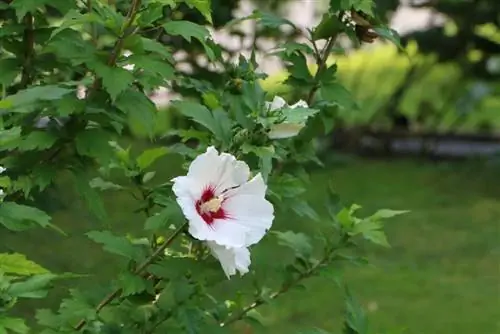
In both cases, the cutting tools for your garden hibiscus should be placed in the solution and left completely submerged for at least two minutes. Then either dry with a clean cloth or, even better, don't dry but let it drip.
Chemical disinfection
You don't have to worry about any fungal or bacterial residue on your garden hibiscus if you dip your cutting tool into it before pruning in the fall season. The remedy “Dimanin” from BAYER, for example, is ideal here. As a five percent solution and with an immersion time of just one minute, all harmful residues on scissors or knives are reliably killed.
Cutting technique
In order to expose the hibiscus to as little stress as possible when cutting and of course to prevent disease, we recommend using a cutting technique in which you make smooth cuts directly on the trunk or branch. In addition, an oblique cut should be made. This ensures that the interface is reduced in size. In addition, the water drips off easily on an inclined cut, so that the interface can dry better and any bacteria that may be present are removed with the (rain) water. If the diagonal cut on sloping branches is made so that the longer attachment is at the top, ideally the cut will not be hit by water and will dry even better.
After the cut
Autumn usually always brings with it a lot of humid weather. This means that the interfaces on a garden hibiscus heal/dry much more slowly than would be the case in warm, dry temperatures. With the interfaces open longer, the risk of illness automatically increases. Even without dirty cutting tools, fungal spores can reach the inside of plant parts via the wind and spread there, usually unnoticed, throughout the winter. But viral infections are also among the dangers that can penetrate the plant through moist interfaces. Therefore, interfaces on a garden hibiscus should always be treated in the autumn season. The following products are suitable for this and are applied to the cuts:
- Coal powder
- Resin
- Cinnamon
- Wax
- Zinc dust
Tip:
In an extremely humid autumn season, it is recommended to first pre-treat with cinnamon or charcoal powder for disinfection and then seal the interfaces with wax or resin. Zinc dust takes on both properties, disinfects a little and clogs the capillaries.
Cutting types
Pruning can have several reasons. Autumn pruning of garden hibiscus is particularly recommended because of its growth. This can be divided into different areas in terms of the types of cuts.
Educational Cut
The term “educational cut” suggests that this is a growth cut for young garden hibiscons. From the first year of life onwards, the young plants should be cut back regularly in the autumn months so that they branch more in each subsequent year. In the first few years this is quite easy because there are usually only a few shoots. With every year the hibiscus becomes fuller and the effort increases accordingly.
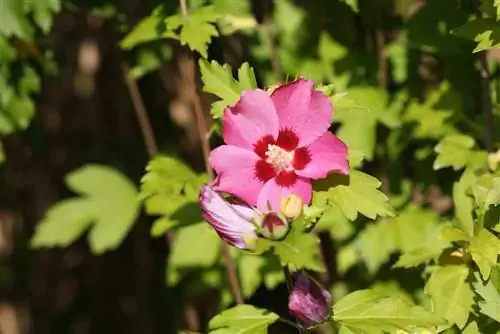
Autumn pruning should always be done generously by shortening all shoots and the trunk by three quarters. The training cut only ends in the year when the plant is densely overgrown and has no/hardly any light spots. Afterwards, cuts can be made as required, as explained below.
High trunk pruning
The standard pruning is a type of training pruning in which a young garden hibiscus is pruned so that wonderfully bushy foliage with magnificent flowers forms on a “bare” trunk. The variety “Hibiscus Syriacus Hamabo” is particularly suitable for standard growth, which requires a lot of patience because it takes between four and six years until it is professionally cut.
Cut your plants as follows:
- First year: Cut side branches except for two or three buds - trunk remains untouched
- Subsequent years: Cut off all branches except for one bud - the leading shoot is shortened to five or six eyes
- Final cut: Cut the trunk at the desired height - remove all side shoots
- Crown preserved: Only cut back well-developed branches except for one or two eyes
Conservation cut
Maintenance pruning for your garden hibiscus is a measure in which you influence the growth form and/or crown growth. The cut is done as follows:
- Dried and diseased branches are cut off
- Short branches that are too long and poorly developed except for three or four eyes
- Separate branches that are very one-sided on the sides just above a low-lying branch
Rejuvenation cut
Over the years, the hibiscus in the garden often becomes increasingly thin. This is usually mainly due to the internal branches, which wither, eat up unnecessary nutrients and take up space for fresh, new shoots. That's why every garden hibiscus needs a rejuvenation cut sooner or later. As a precautionary measure, this can of course be carried out before your garden specimen becomes thinner. Proceed as follows for the rejuvenation cut:
- Heavily thinned out: Strong pruning of two-thirds of all branches and the trunk
- Normally thinned out: Cut back by a third and cut all old, withered branches and cross-growths
- Clearing cut: Thin out and completely cut off dried, shaggy-looking and cross-growing branches
hedge cutting
The garden hibiscus is becoming increasingly popular as a hedge. This requires special pruning in the autumn months so that it has a compact hedge shape and numerous flowers grow on fresh shoots every summer. Pruning should be carried out in September or October as follows:
- Complete pruning by a third
- Complete pruning every year
- Cut away dried branches, especially in the inner area
- For straight cutting lines, pull string along the hedge
Tip:
If you cut the hibiscus hedge so that it is slightly slanted towards the top, this will improve the light. This promotes growth and reduces the chance of indoor aging.
Radical cut
A radical cut is particularly recommended if the hibiscus has previously suffered severely from illness or if it has extreme thinning due to its age and/or growth is slow or not even. Although the hibiscus usually tolerates a radical cut well, this still causes stress. Depending on why a radical cut appears to be the solution for he althy and strong growth, it does not always recover afterwards.
Therefore, it is advisable to postpone a radical cut for a few years. This means that the hibiscus is regularly shortened a little throughout the year and a little more in the fall season each year than the year before. You can continue this until the radical cut ends above the first branch on the main stem. This is usually between five and ten centimeters above the earth's surface.


